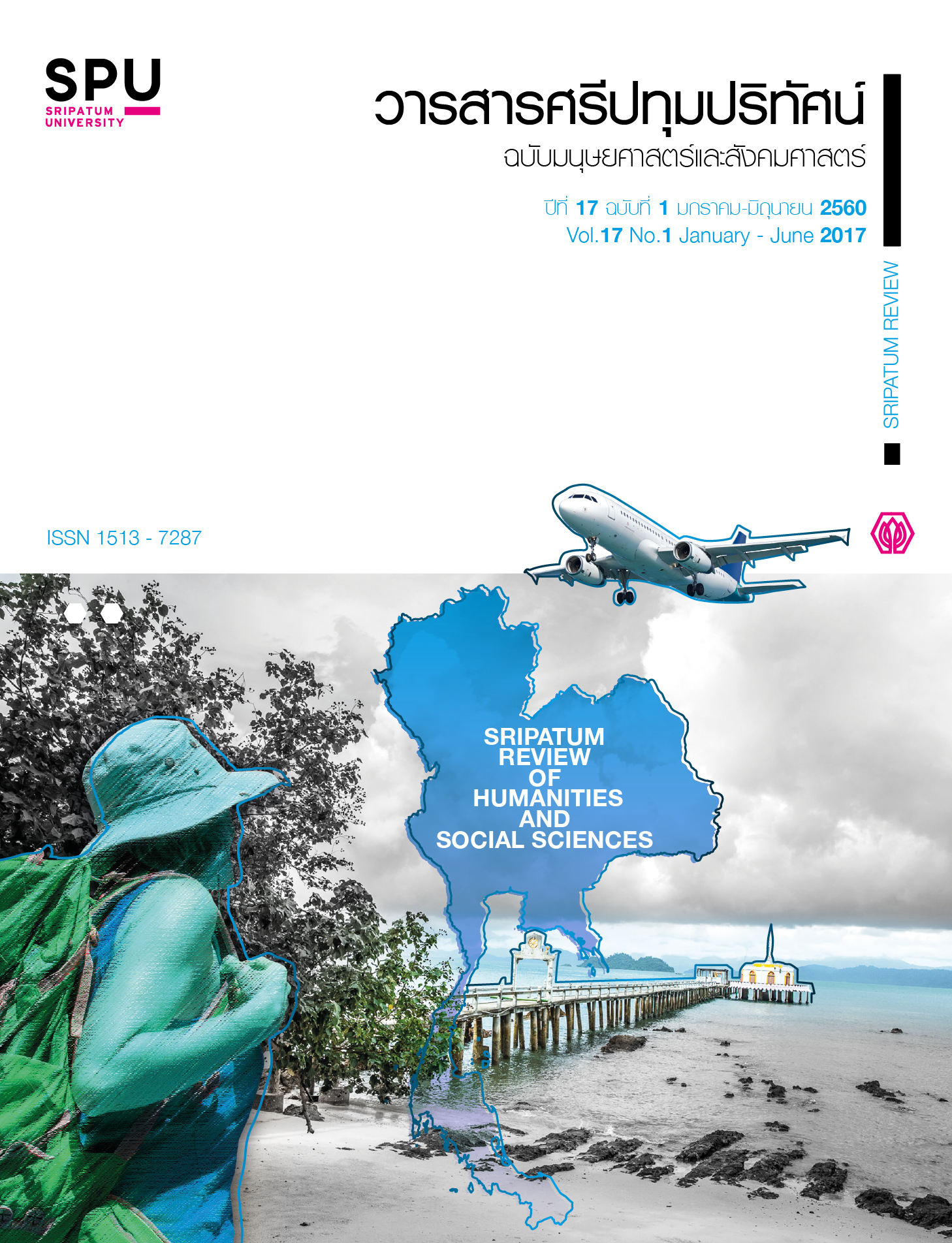UNDERGRADUATE STUDENTS’ EXPERIENCES AND CAPABILITIES FOR HEALTH COMMUNICATION TO ENHANCE QUALITY OF LIFE OF THE ELDERLY
Main Article Content
Abstract
The objectives of this study were (1) to survey the experiences and capabilities of undergraduate students concerning methods of health communication with the elderly; (2) to study the relationships between demographic characteristics and 3 factors of the model of health promotion through interpersonal communication skills with the elderly; and (3) to conclude and propose recommendations for methods of health communication that can enhance better life quality of the elderly. The research sample was chosen through purposive sampling, consisting of 303 students from the Faculty of Communication Arts, Huachiew Chalerm Prakiat University; and the School of Science and Technology and the School of Humanities and Applied Arts, University of the Thai Chamber of Commerce. The data collection tool was a questionnaire with both open-ended and closed-ended questions. Data were statistically analyzed using frequency distribution, percentage, mean, standard deviation, and chi-square test to examine the relationship of variables; while data on recommendations were analyzed with content analysis. The results showed that regarding their experience and capability for health communication, most of the students used the factor of objective of communication the most (39.30%); that is, asking for general happenings about how the elderly were doing on a day-to-day basis. The most common method of communication (31.40%) was the direct verbal communication. Results of testing the relationships among variables showed that objective of communication was related to verbal communication skill and method of communicating with family members was related to communication by explanation at the .05 level of significance. Recommendations from the research sample that can be applied to health communication are that most students want to communicate with the elderly in a humble and respectful way and want to use both words and body language to express love and concern for the elderly on a regular basis.
Article Details
1. กองบรรณาธิการสงวนสิทธิ์ในการพิจารณาและตัดสินการตีพิมพ์บทความในวารสาร
2. บทความทุกเรื่องจะได้รับการตรวจสอบทางวิชาการโดยผู้ทรงคุณวุฒิ แต่ข้อความและเนื้อหาในบทความที่ตีพิมพ์เป็นความรับผิดชอบของผู้เขียนแต่เพียงผู้เดียว มิใช่ความคิดเห็นและความรับผิดชอบของมหาวิทยาลัยศรีปทุม
3. การคัดลอกอ้างอิงต้องดำเนินการตามการปฏิบัติในหมู่นักวิชาการโดยทั่วไป และสอดคล้องกับกฎหมายที่เกี่ยวข้อง
References
คณะอนุกรรมการสถิติสาขาสุขภาพและคณะทำงานสถิติด้านสุขภาพ. 2557. แผนพัฒนาสถิติ สาขาสุขภาพฉบับที่ 1 พ.ศ. 2557 – 2558. นนทบุรี: กระทรวงสาธารณสุข.
แผนงานวิจัยและพัฒนาระบบสื่อสารสุขภาพสู่ประชาชนสถาบันวิจัยระบบสาธารณสุข. 2551. การสื่อสารสุขภาพ.พิมพ์ครั้งที่ 2. กรุงเทพฯ: ภาพพิมพ์.
จุฑามณี กันกรุง, ไพลิน เขียวอินทร์, สุนารี แซ่เถา และจิตศิรินลายลักษณ์. 2557. “การศึกษาความฉลาดทางสุขภาวะของนักศึกษาปริญญาตรี มหาวิทยาลัยราชภัฏพิบูลสงคราม.” วิทยานิพนธ์ สาขาวิทยาศาสตร์สุขภาพคณะวิทยาศาสตร์และเทคโนโลยี มหาวิทยาลัยราชภัฏพิบูลสงคราม.
ธีรนันท์ วรรณศิริ และสมบัติ ประทักษ์กุลวงศา. 2559.“การพัฒนาสัมพันธภาพวัยรุ่นและผู้สูงอายุในครอบครัวของชุมชนโพรงมะเดื่อ” วารสารวิจัยเพื่อการพัฒนาเชิงพื้นที่, 8(1): 100-115.
ปัทมา ว่าพัฒนวงศ์ และปราโมทย์ ประสาทกุล. 2549.ประชากรไทยในอนาคต. นครปฐม: สถาบันวิจัยประชากรและสังคม มหาวิทยาลัยมหิดล.
ปาริชาต สถาปิตานนท์, กิตติ กันภัย, พัฒนพงส์ จาติเกตุและปิยะนารถ จาติเกตุ. 2546. การสื่อสารสุขภาพศักยภาพของสื่อมวลชนในการสร้างเสริมสุขภาพ.กรุงเทพฯ: จุฬาลงกรณ์มหาวิทยาลัย.
ภูริชญา เทพศิริ. 2557. “คุณภาพชีวิตของผู้สูงอายุในตำบลทองหลาง อำเภอบ้านนา จังหวัดนครนายก.”สารนิพนธ์หลักสูตรรัฐประศาสนศาสตรมหาบัณฑิต มหาวิทยาลัยเกริก.
สมพร โพธินาม, พิศ แสนศักดิ์, จงกล พูลสวัสดิ์, วิรัตน์ ปานศิลา,ชนิศา ปานศิลา, ชนัตถา พลอยเลื่อมแสง และคณะ.2552.“ผู้สูงอายุไทย บริบทของจังหวัดมหาสารคาม.”ศรีนครินทร์เวชสาร 2552. 24(3): 197-205.
สำนักงานคณะกรรมการการศึกษาขั้นพื้นฐาน (สพฐ.). 2555.ทักษะชีวิต . สืบค้นเมื่อวันที่ 16 กรกฎาคม 2559 .
สำนักงานกองทุนสนับสนุนการสร้างเสริมสุขภาพ (สสส.). 2555.การเจ็บป่วยและการตาย. สืบค้นเมื่อวันที่ 25 พฤศจิกายน 2559
สุธาสินี เลิศวัชระสารกุล. 2557. 9 ทักษะที่ควรมีก่อนเรียนจบ.สืบค้นเมื่อวันที่ 27 กรกฎาคม 2559
สำนักงานสถิติแห่งชาติ. 2559. เตรียมตัวให้พร้อมไว้...ในวัยผู้สูงอายุ (ตอนที่ 1). สืบค้นเมื่อวันที่ 20 กรกฎาคม 2559
Glass, A. 2007. “Understanding generational differences for competitive success”, Industrial and Commercial Training, 39(2): 98–103.
Jung, Y., Koay, J. L., Ng., J. S., Wong, G. L. C., & Lee, K. M. 2009. “Games for a better life : effects of playing wii games on the well-being of seniors in a long-term care facility.” Proceedings of the 6th Australasian Conference on Interactive Entertainment 2009. (IE 2009), Australia.
Lazarsfeld, P. & Merton, R. K. 1964. Friendship as a Social Process: A Substantive and Methodological Analysis. In M. Berger, T. Abel, & C. H. Page (Eds.), Freedom and Control in Modern Society (pp. 18-66) New York: Van Nostrand.
Nguyen Hai, T.T., Tapanainen, T., Theng, Y.L. et al. 2015. Fostering Communication between the Elderly and the Youth with Social Games. Retrieved September 17, 2016
Pender, N.J. 1987. Health Promotion in Nursing Practice. 2nd ed. Norwalk : Appleton & Lange. Shubert, T. E. 2010. “The use of commercial health video games to promote physical activity in older adults.” Annals of Long-Term Care: Clinical Care and Aging, 18(5): 27–32.
Theng, Y. L., Chua, P. H., & Pham,T.P. 2012. “Wii as entertainment and socialisation aids for the ental and social health of the elderly.” In: CSI 2012 Extended Abstracts on Human Factors in Computing Systems, pp. 691-702. ACM, May 2012.


